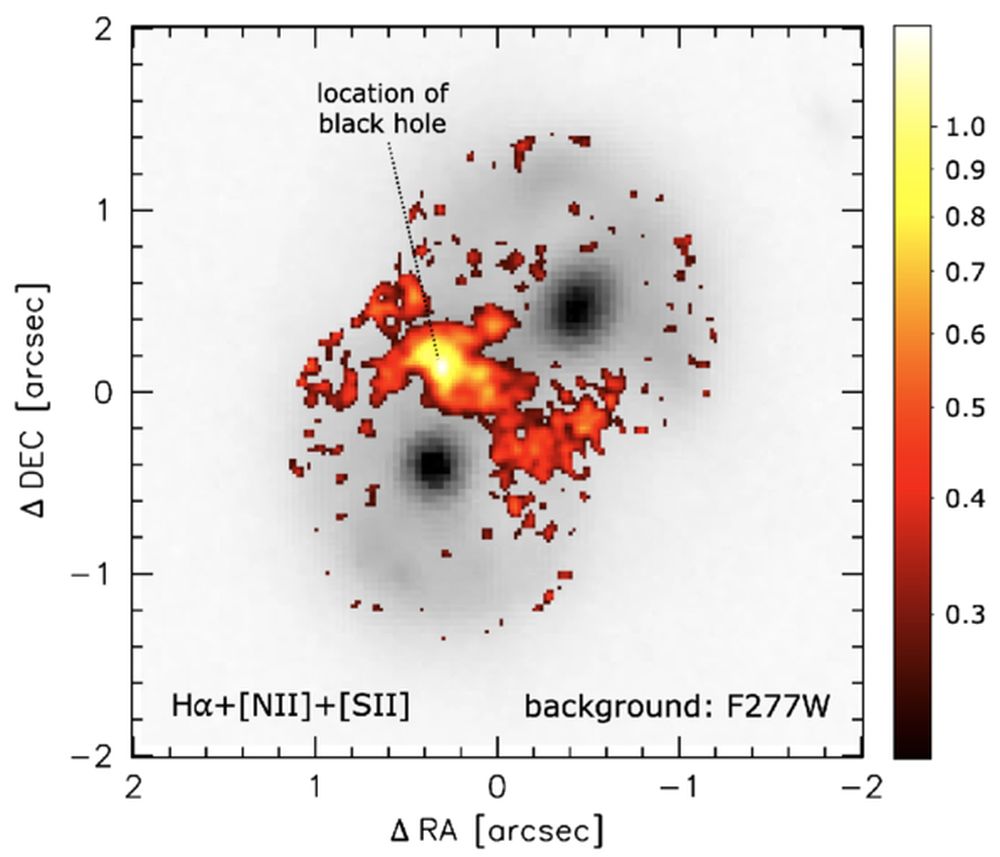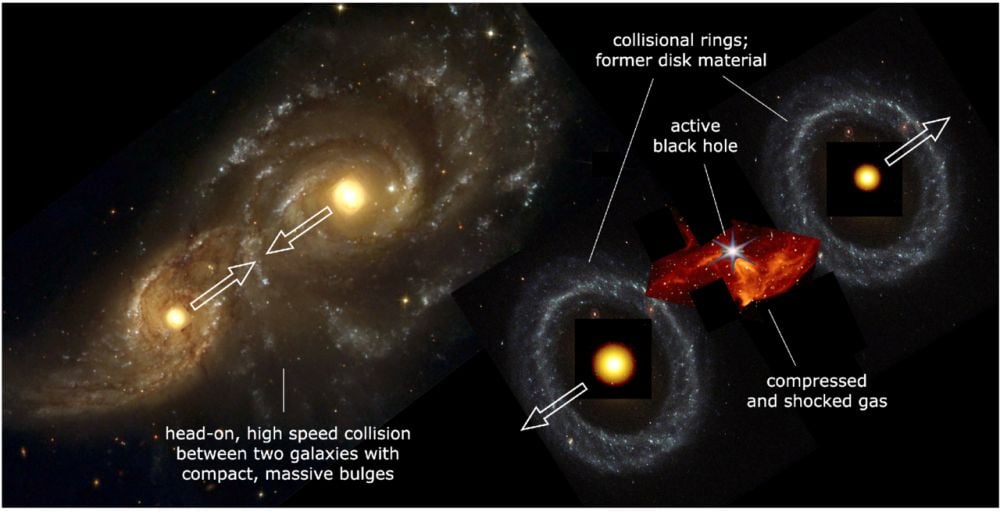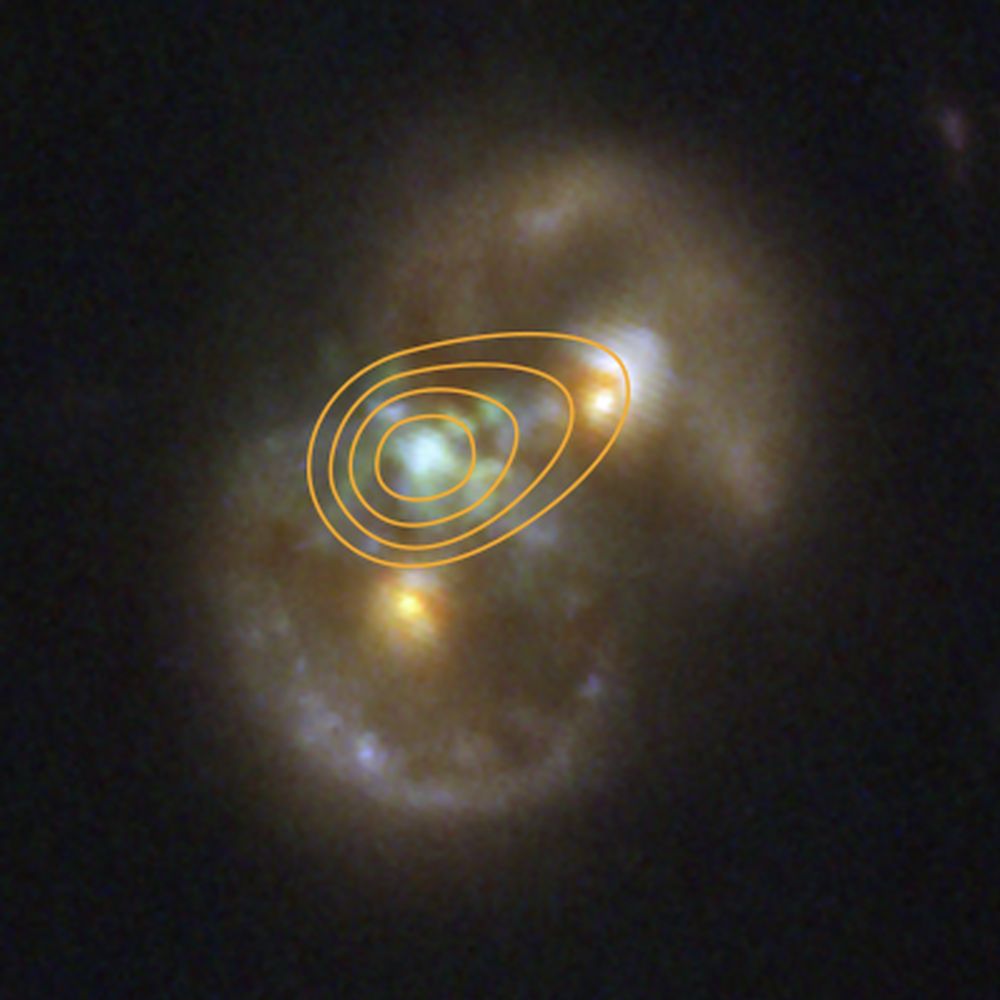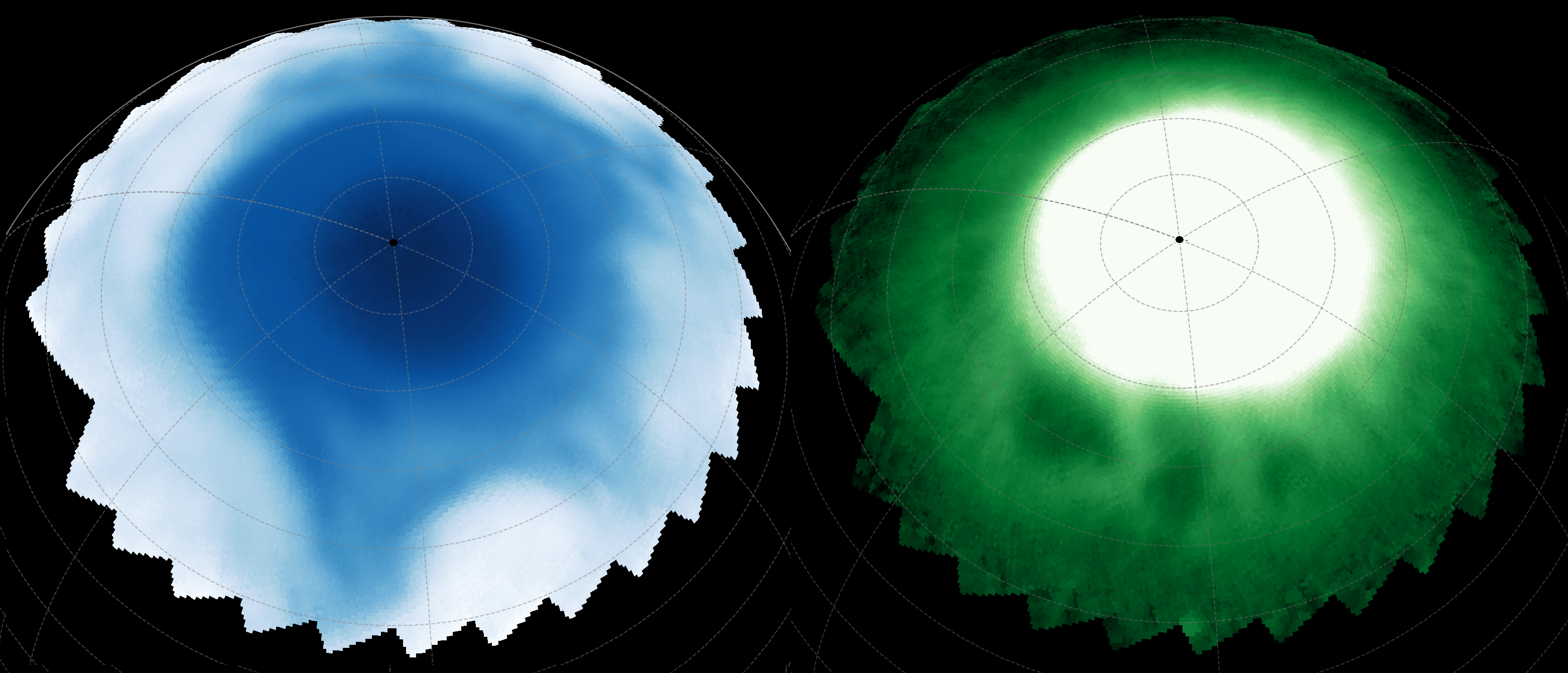Astrophysicists don’t know if direct-collapse black holes are real. They were hypothesized to explain how the Universe could contain supermassive black holes (SMBH) so early. They don’t require a stellar progenitor, nor do they require hierarchical merging. Instead, they collapse due to instability in a gas cloud, much like stars do.
Recently, astronomers working with images from the COSMOS-Web survey, a JWST survey observing more than one million galaxies across cosmic time, found something odd. It’s a double-nuclei galaxy likely formed by the collision of two galaxies. They nicknamed it the Infinity Galaxy because it resembles the infinity symbol.
But that’s not the odd part.
A supermassive black hole (SMBH) lies between the two, rather than in the nuclei. It sits in a vast field of gas, and researchers think it could be a much-hypothesized direct-collapse black hole. If it is, it can explain why there are such massive black holes so early in cosmic time.
Pieter van Dokkum is a Professor of Astronomy and Physics at Yale University. He’s the lead author of a paper presenting the discovery, titled “The Infinity Galaxy: a Candidate Direct-Collapse Supermassive Black Hole Between Two Massive, Ringed Nuclei,” published in The Astrophysical Journal Letters.
“…we think we’re witnessing the birth of a supermassive black hole – something that has never been seen before.” – Pieter van Dokkum, Yale University.
“We report the discovery of an unusual z=1.14 object, dubbed the Infinity galaxy, in JWST imaging of the COSMOS field,” the paper states.” The authors say it’s morphology suggests it was created when two galaxies with parallel disks collided, creating collisional rings around both galaxies. Keck, Chandra, and VLA data all indicate that the Infinity galaxy hosts an actively-accreting SMBH. “Remarkably, the SMBH is not associated with either of the two nuclei, but is in between them in both position and radial velocity,” the paper states.
 This figure from the research shows JWST images of the Infinity galaxy. Image Credit: van Dokkum et al. 2025.
This figure from the research shows JWST images of the Infinity galaxy. Image Credit: van Dokkum et al. 2025.
“We suggest that the SMBH formed within this gas in the immediate aftermath of the collision, when it was dense and highly turbulent,” van Dokkum and his co-authors wrote. They explained that follow-up observations with the JWST could corroborate the detection, and “would demonstrate that `direct’ SMBH formation by a runaway gravitational collapse is possible in extreme conditions.”
“Everything is unusual about this galaxy. Not only does it look very strange, but it also has this supermassive black hole that’s pulling a lot of material in,” van Dokkum said in a press release. “The biggest surprise of all was that the black hole was not located inside either of the two nuclei but in the middle. We asked ourselves: How can we make sense of this?”
“Finding a black hole that’s not in the nucleus of a massive galaxy is in itself unusual, but what’s even more unusual is the story of how it may have gotten there,” van Dokkum continued. “It likely didn’t just arrive there, but instead it formed there. And pretty recently. In other words, we think we’re witnessing the birth of a supermassive black hole – something that has never been seen before.”
 This figure from the research shows H-alpha, NII, and SII emissions that locate the SMBH between the pair of nuclei in the Infinity galaxy. Image Credit: Pieter van Dokkum et al 2025 ApJL 988 L6
This figure from the research shows H-alpha, NII, and SII emissions that locate the SMBH between the pair of nuclei in the Infinity galaxy. Image Credit: Pieter van Dokkum et al 2025 ApJL 988 L6
There are two theories to explain the formation of SMBHs. They’re the ‘light seeds’ and ‘heavy seeds’ theories. The light seeds scenario begins with stellar mass black holes that are created when massive stars explode as core-collapse supernovae. These black holes can have up to 1,000 solar masses, maybe more. If enough of them are concentrated in one area, successive mergers over time create SMBHs. “The problem is, that merger process takes time, and Webb has found incredibly massive black holes at incredibly early times in the universe – possibly even too early for this process to explain them,” van Dokkum said.
In the heavy seeds scenario, an SMBH with up to one million solar masses forms through direct-collapse of a gas cloud. This happens quickly without mergers or stellar progenitors. “However, the problem with forming a black hole out of a gas cloud is that gas clouds like to form stars as they collapse rather than a black hole, so you have to find some way of preventing that. It’s not clear that this direct-collapse process could work in practice,” van Dokkum explained.
van Dokkum says that he and his co-researchers have pieced together a narrative from the scientific observations that explains the Infinity galaxy. Two disk galaxies collided billions of years ago and formed the ring structures around the galaxies. The collision shocked and compressed the galaxies’ gas enough to form a density which collapsed directly into a black hole.
 This schematic explains how a head-on collision between two galaxies with massive, compact bulges could create the Infinity galaxy. “The bulges survived the collision, and the inner disk stars were swept up in outwardly expanding collisional rings around the bulges,” the authors explain. “Compression and shocks in the colliding gas likely produced a dense gaseous remnant in between the nuclei, as has been observed in the bullet cluster on much larger scales. It is proposed that the black hole formed within this gas. Image Credit: Pieter van Dokkum et al 2025 ApJL 988 L6
This schematic explains how a head-on collision between two galaxies with massive, compact bulges could create the Infinity galaxy. “The bulges survived the collision, and the inner disk stars were swept up in outwardly expanding collisional rings around the bulges,” the authors explain. “Compression and shocks in the colliding gas likely produced a dense gaseous remnant in between the nuclei, as has been observed in the bullet cluster on much larger scales. It is proposed that the black hole formed within this gas. Image Credit: Pieter van Dokkum et al 2025 ApJL 988 L6
“There is quite a bit of circumstantial evidence for this,” van Dokkum explained. “We observe a large swath of ionized gas, specifically hydrogen that has been stripped of its electrons, that’s right in the middle between the two nuclei, surrounding the supermassive black hole. We also know that the black hole is actively growing – we see evidence of that in X-rays from NASA’s Chandra X-ray Observatory and radio from the Very Large Array. Nevertheless, the question is, did it form there?”
 This JWST image of the Infinity galaxy shows contour maps from radio data from the Very Large Array (VLA). The center pinpoint of radio emission perfectly lines up with the center of the glowing gas detected in the infrared in between the two nuclei of the galaxies. The radio emissions from the SMBH indicate that it is actively accreting material and growing. Image Credit: NASA, ESA, CSA, STScI, VLA, P. van Dokkum (Yale University)
This JWST image of the Infinity galaxy shows contour maps from radio data from the Very Large Array (VLA). The center pinpoint of radio emission perfectly lines up with the center of the glowing gas detected in the infrared in between the two nuclei of the galaxies. The radio emissions from the SMBH indicate that it is actively accreting material and growing. Image Credit: NASA, ESA, CSA, STScI, VLA, P. van Dokkum (Yale University)
Of course, there are other possibilities that can’t yet be ruled out. “First, it could be a runaway black hole that got ejected from a galaxy and just happens to be passing through,” van Dokkum said. Or it could be an SMBH in a third galaxy in the same location. To be unseen, it would likely need to be a dwarf galaxy. The only problem is, dwarf galaxies don’t host SMBH.
If either of those scenarios were true, then the SMBH’s gas velocity would be different from the gas velocity in the Infinity galaxy. The researchers requested and received additional JWST observing time to measure the gas velocities. If the velocities were close together, then that would strengthen the idea that it’s a direct-collapse black hole.
“We applied for and received director’s discretionary time to follow up on this target with Webb, and our preliminary results are exciting. First, the presence of an extended distribution of ionized gas in between the two nuclei is confirmed,” van Dokkum said. “Second, the black hole is beautifully in the middle of the velocity distribution of this surrounding gas – as expected if it formed there. This is the key result that we were after!”
But the additional JWST observations held another unexpected surprise. They revealed two additional SMBHs, one in each galaxy.
“We can’t say definitively that we have found a direct collapse black hole. But we can say that these new data strengthen the case that we’re seeing a newborn black hole, while eliminating some of the competing explanations. We will continue to pore through the data and investigate these possibilities.”
“If our proposed scenario is confirmed, the Infinity galaxy provides an empirical demonstration that direct-collapse formation of SMBHs can happen in the right circumstances—something that has so far only been seen in simulations and through indirect observations,” the authors conclude.
Source link


